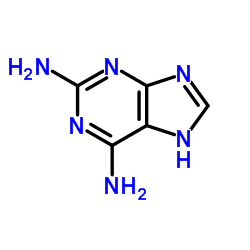Two isomorphous transition metal complexes containing a protonated diaminopurine ligand: diaquabis(2,6-diamino-7H-purin-1-ium-κN9)bis(homophthalato-κO)nickel(II) tetrahydrate and the cobalt(II) analogue.
Ana María Atria, Gino Corsini, Natalia Herrera, Maria Teresa Garland, Ricardo Baggio
文献索引:Acta Crystallogr. C 67(Pt 5) , m169-72, (2011)
全文:HTML全文
摘要
The two isomorphous title compounds, [M(C(5)H(7)N(6))(2)(C(9)H(6)O(4))(2)(H(2)O)(2)]·4H(2)O or M(2+)(Hdap(+))(2)(hpt(2-))(2)(H(2)O)(2)·4H(2)O {where dap is 2,6-diaminopurine, H(2)hpt is homophthalic acid [2-(2-carboxyphenyl)acetic acid] and M is Ni(II) or Co(II)}, consist of neutral M(2+)(Hdap(+))(2)(hpt(2-))(2)(H(2)O)(2) monomers, where the M(II) cation lies on an inversion centre and its MN(2)O(4) octahedral environment is defined by one N atom (from Hdap(+)), two O atoms (from one hpt(2-) dianion and one water molecule) and their inversion images. The structures are unusual in that the Hdap(+) cation occurs in an uncommon protonated state (as 2,6-diamino-7H-purin-1-ium) and both ligands bind in an unprecedented monodentate fashion. The existence of a large number of donors and acceptors for hydrogen bonding, together with π-π interactions, leads to a rather complex three-dimensional structure.© 2011 International Union of Crystallography
相关化合物
| 结构式 | 名称/CAS号 | 分子式 | 全部文献 |
|---|---|---|---|
 |
2,6-二氨基嘌呤
CAS:1904-98-9 |
C5H6N6 |
|
Effect of substituents on the excited-state dynamics of the ...
2010-01-01 [Phys. Chem. Chem. Phys. 12(20) , 5375-88, (2010)] |
|
Formation and helicity control of ssDNA templated porphyrin ...
2013-02-01 [Chem. Commun. (Camb.) 49(10) , 1020-2, (2013)] |
|
Simulations of A-RNA duplexes. The effect of sequence, solut...
2012-08-23 [J. Phys. Chem. B 116(33) , 9899-916, (2012)] |
|
Biotransformation of 2,6-diaminopurine nucleosides by immobi...
2012-01-01 [Biotechnol. Prog. 28(5) , 1251-6, (2012)] |
|
Recombination R-triplex: H-bonds contribution to stability a...
2006-01-01 [Nucleic Acids Res. 34(11) , 3239-45, (2006)] |